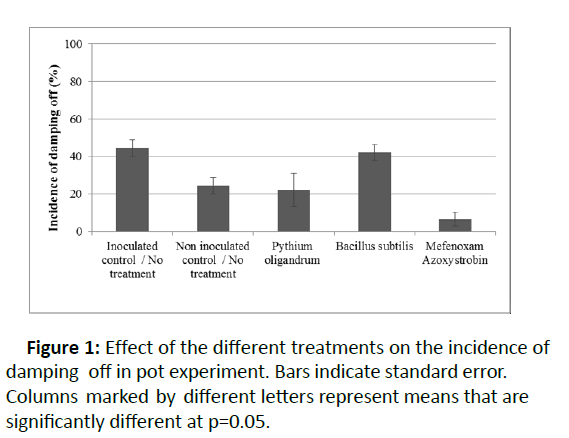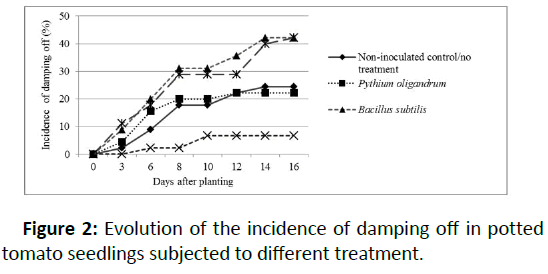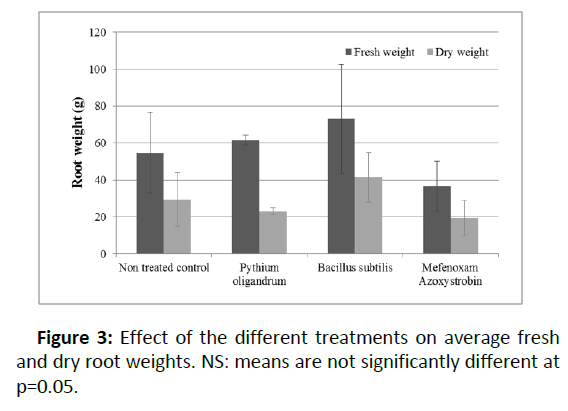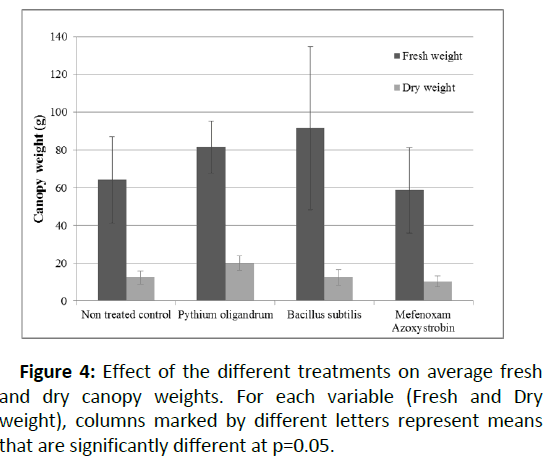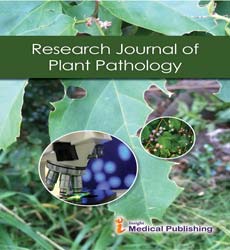Evaluation of Different Control Measures against Damping-off in Greenhouse Solanaceous Crops
Wassim Habib1*, Carine Saab1, Elvis Gerges1, Christian Al Kareh2 and Rita Gerges2
1 Department of Plant Protection, Lebanese Agricultural Research Institute, Fanar, Lebanon
2 Department of Agricultural and Food Sciences, Holy Spirit University of Kaslik, Jounieh, Lebanon
- *Corresponding Author:
- Wassim Habib
Department of Plant Protection,
Lebanese Agricultural Research Institute,
Fanar,
Lebanon,
E-mail:whabib@lari.gov.lb
Received Date: April 15, 2021;Accepted Date: April 29, 2021;Published Date: May 06, 2021
Citation: Habib W, Saab C, Gerges E, Kareh CA, Gerges R (2021) Evaluation of Different Control Measures against Damping off in Greenhouse Solanaceous Crops. J Plant Pathol Vol.4 No.3:4.
Abstract
Increased losses due to damping off disease have been reported recently on protected Solanaceous crops in Lebanon; however, no efficient treatment has been identified. In-pot and field experiments were done in greenhouses to assess the efficacy of several commercial formulations of pesticides in controlling damping off, and determine their effect on plant growth. The treatments were two commercial formulations of biological control agents, Pythium oligandrum and Bacillus subtilis, and a mixture of Mefenoxam+Azoxystrobin. The results showed that Pythium oligandrum has reduced the incidence of damping off by the half comparing to the positive untreated control and was more efficient than B. subtilis, with a disease incidence of 22.2% and 42.2%, respectively, in the pot experiment. In field experiment, the average incidence of the disease was generally low independently from the treatment performed (5.2%) and the evaluation of the growth parameters indicated that both B. subtilis and P. oligandrum formulations were able to enhance the growth of plants compared to the untreated control. Therefore, P. oligandrum could be used in the management of damping-off; however, further research studies are needed in order to optimize its application in the field.
Keywords
Biological control agents; Pythium oligandrum; Bacillus subtilis; Disease management; Growth promoters
Introduction
Damping-off is a destructive disease of plant seedlings, caused by several soil-borne fungi including Rhizoctonia solani, Pythium spp., Phytophthora spp., Sclerotinia spp. and Fusarium spp. [1]. In particular, pre- and post-emergence damping-off caused by Pythium spp. in vegetable crops is economically very important worldwide [2]. Pythium spp. are fungal-like organisms (Oomycetes), commonly referred to as water molds, which naturally exist in soil and water as saprophytes, feeding on organic matter. Some Pythium spp. can cause serious diseases on greenhouse vegetable crops resulting in significant crop losses. Infections by Pythium lead to damping-off in seedlings and crown and root rot of mature plants. Several Pythium spp., including P. aphanidermatum, P. irregulare and P. ultimum are known to cause damping off and crown and root rot in greenhouse cucumber, pepper and tomato crops [3]. Several measures including chemical, cultural and biological control are available for the management of damping off. Chemical treatments commonly used in nurseries and fields are mainly based on metalaxyl, hymexazol, propamocarb or others. Removal and disposal of diseased plants, crop rotation, improved soil drainage and air circulation, reduced nitrogen fertilization and soil solarisation are also essential for the successful management of damping off disease [4]. Because of the potential negative impacts of chemical pesticides on the environment and consumers, several Biological Control Agents (BCAs) genera of fungi and bacteria have been recently integrated in programs of disease management and their effectiveness in controlling soil borne diseases is well-documented [5-7].
Pythium oligandrum Dreschler, in particular, is a soil inhabitant oomycete, considered as the most promising BCA for use in agriculture. It interacts directly with the fungal pathogens through distinct or combined mode of actions, such as mycoparasitism, antibiosis, nutrient and space competition, and/or indirectly by inducing resistance in the plants [8,9]. An impressive number of soil-borne diseases of various plants can be controlled by P. oligandrum, such as: black scurf of potato caused by Rhizoctonia solani [10]. Grapevine trunk wood disease caused by Phaeomoniella chlamydospora [11]. Verticillium wilt of pepper caused by Verticillium dahliae damping off and root diseases of sugar beet caused by Pythium ultimum [12,13] among others. Today, the emergence of resistant pathogen strains to currently used pesticides, the increasing consumer demand for food products without toxic residues and the international objective to preserve as much as possible the environment and human health compromise the use of pesticides and favour the introduction of novel alternatives. Among these, activating plant defence responses by using BCAs is a promising strategy for replacing or at least reducing chemical applications [9].
Because plant diseases cause billions of dollars in harvest loss annually with huge consequences in developing countries, the improvement of management strategies that can be reliable and safe for the environment is urgently needed. Particularly in Lebanon, farmers of protected crops on coastal areas have long suffered from severe losses of their seedlings at the early phases of the growing season and yet, none of the treatment type adopted was satisfying. Therefore, the aim of this study was to assess the efficacy of a Pythium oligandrum commercial formulation in controlling damping off disease caused by Pythium spp. on Solanaceous hosts in vivo trials, and determine its effect on plant growth.
Materials and Methods
Two experiments (in-pot and in-soil experiments) were carried out in Amchit, Jbeil district, Mount Lebanon at the sea level in two separate greenhouses during the period August-October 2016.
In-pot experiment
Artificial inoculation/Preparation of the broth: The culture liquid medium or broth was prepared based on the protocol [14] slightly modified by mixing 500 ml tomato sauce and 5 g CaCO3 (Sigma-Aldrich, St Louis, Germany). After filtration through a cheesecloth, 250 ml of the mix were diluted with water to 1 L final volume and then autoclaved.
Inoculum preparation: Inoculum was produced as described by [15]. An isolate of Pythium aphanidermatum (PytA), obtained from the same greenhouse where plant previously showed symptoms of damping-off, was identified prior to this experiment based on morphological characteristics and molecular analysis and used in the experiment. The isolate was grown on Potato Dextrose Agar (PDA, Himedia Laboratories, India) medium at 31°C in the dark for 24 hours. Five agar plugs (5 mm) collected from the leading edges of mycelial growth were then transferred into 10 Petri dishes containing the broth. After incubating the plates at 31°C in the dark overnight, the mycelial mats obtained were washed with sterile deionized water three times, flooded in sterile deionized water, and incubated at room temperature of 24°C for 48 hours under white fluorescent lights. The mats were then blended in a clean blender on high speed for 2 minutes and then filtered through a four-ply layer of sterile cheesecloth to collect oospores. The residues on the cheesecloth were collected with sterile deionized water in a sterile 50 ml falcon tube. The concentration of P. aphanidermatum oospores in the resultant suspension was determined using a hemacytometer (Bright-Line, Sigma-Aldrich). The final concentration of the oospore’s suspension (2 L) used in artificial inoculations used was 1 × 107 oospores/ml.
Inoculation: The pots (12 cm) were previously filled with the greenhouse soil in which the experiment was done. Each pot received 5 ml of sterile water then 10 ml of oospore suspension using a pipette. Inoculation was performed late in the afternoon to avoid the highest daily temperatures. Pots were placed on plastic film to prevent contamination of the greenhouse soil and kept in the greenhouse for 5 days for acclimatization. In each pot, one tomato seedling at 2-3 leaf growth stage was planted in the inoculated soils. The hybrid DSW-8125 tomato by Seminis (Bayer) was used. During the whole period of the experiment, the greenhouse was tightly closed and pots were watered each two days, in order to create the favourable climatic conditions for P. aphanidermatum growth.
Experimental design: The experiment was done in a randomized complete block design (RCBD) with three blocks, five treatments-
• (Polyversum commercial formulation by Biopreparaty, Czeck Republic),
• (Fulzyme Plus-SP commercial formulation by Biotech, California, USA) and
• Mefenoxam+Azoxystrobin (Uniform commercial formulation by Syngenta, North Carolina, USA),
• Negative control (non-inoculated soil and no damping off treatment),
• Positive control (Inoculated soil and no damping off treatment) and 15 replicates of potted tomato plants. The treatments, their composition, their conditions of application and their dose are shown in .
Data collection: The incidence of damping off was determined each two days for a total period of two weeks, by calculating the percentage of dead plants in each group.
In-soil experiment
Experimental design: The second experiment was done in a greenhouse, in which the soil is naturally infected by Pythium spp., that measured 25 m in length and 7 m in width, and divided into 12 plots. Three treatments together with a negative untreated control were set in RCBD design with three blocks and in average 40 eggplant plants of the hybrid Negra by Seminis (Bayer), at the 4-5 leaf stage, per treatment in each block. Application of the treatments was done respecting the recommendations on the labels in Table 1. Irrigation was done each 2-3 days in order to create good conditions for infection by Pythium.
| Treatment | Formulation | Conditions of application | |
|---|---|---|---|
| In-pot experiment | In-soil experiment | ||
| Polyversum | Pythium oligandrum (1%) | Drenching directly after transplanting | Dipping the roots of seedlings in suspension for 10 min before planting |
| Applied dose: 20 g for 2500 plants | Applied dose: 15 g for 2500 plants | ||
| Fulzyme plus-SP | Bacillus subtilis (2 × 1010/gram) | Drenching directly after transplanting | Applied two days before planting by drenching |
| Applied dose: 100 g for 2500 plants | Applied dose: 100 g for 2500 plants | ||
| Uniform | Mefenoxam (10.9%) | Drenching directly after transplanting | Applied directly after planting by drenching |
| Azoxystrobin (28.2%) | Applied dose: 125 ml for 2500 plants | Applied dose: 125 ml for 2500 plants | |
Table 1: Treatments against damping off disease used in pot and soil experiments, their formulation, their application mode and dose.
Data collection: Incidence of Damping off: The incidence of damping off on eggplants was monitored each two days for a period of two weeks and determined through dividing the number of symptomatic plants by the total number per plot.
Plant height: In each plot, 10 plants were randomly labelled and their height was measured using a ruler each 7 days for a period of one month.
Fresh and dry weight: One month after planting, three plants in each plot were uprooted from the greenhouse. The canopy was separated from the root system and the fresh weight was then measured. The dry weight was determined after placing them in the oven for 24 hours at a temperature of 70°C.
Statistical analysis
The significance of the difference between the treatments for damping off, plant height and fresh/dry weight was determined by the Analysis of Variance (ANOVA). Tests were performed using IBM SPSS Statistics software version 21.
Results
Effect of different treatments on damping off
Pot experiment: The percentage of damping off two weeks after planting is shown in Figure 1. The incidence was the highest (44.4%) in the positive control (inoculated control/no treatment), whereas the lowest percentage of disease (6.7%) was detected in seedlings treated with the synthetic chemical product Uniform (Mefenoxam+Azoxystrobin). Treatment with Fulzyme Plus-SP (Bacillus subtilis) was not capable of reducing the incidence of the disease (42.2%). Compared to the inoculated non-treated control, treatment with Polyversum (P. oligandrum) reduced the incidence of damping off by the half to 22.2%, although no significant difference between the means was observed. This value was also comparable to the incidence of damping off in the non-inoculated control (24.4%), which represents the infection by the inoculum naturally present in the potting soil. The evolution of the incidence of the disease during the first two weeks after planting was also studied in Figure 2. In general, the incidence of damping off increases mainly in the first week after planting. The disease continues to appear in plants treated with B. subtilis and untreated inoculated (positive) control even after two weeks. On the other hand, plants treated with P. oligandrum were mainly infected by damping off during the first week after planting. Treatment with the mixture Mefenoxam+Azoxystrobin was the most efficient in preventing the infection during the first week after planting. The plants, later on, seemed to acquire a resistance.
Figure 2: Evolution of the incidence of damping off in potted tomato seedlings subjected to different treatment.
In-soil experiment: In the in-soil experiment, the effect of the same treatments on the incidence of damping off was determined on eggplant seedlings planted in naturally infected soil. Eggplant seedlings were used because they are usually more sensitive to infections and they express more evidently the symptoms of the disease [16]. Two weeks after transplanting, we could notice that the average incidence of the disease was generally low independently from the treatment performed. The low percentage of damping off in the non-treated control plots (5.2%) indicates that the infection in the greenhouse was low during the year of study. The highest incidence of damping off (7.6%), surprisingly, was revealed on plants treated with P. oligandrum by dipping at the moment of transplanting.
Both B. subtilis and the mixture (Mefenoxam+Azoxystrobin) were able to reduce the incidence of damping off to 2.1% and 0.9%, respectively, compared to the non-treated control. Nevertheless, differences between the means were not significant at p=0.05, probably due to the low percentages found.
Effect of treatments on agronomic performance
Plant height:The effect of the different treatments in the in-soil experiment on the growth of eggplant plants was evaluated through the height parameter in Table 2. In all the studied treatments, the height of the eggplant seedlings increased although with slight differences. One week after planting, all treatments except P. oligandrum had statistically similar effect on plant height since the average height of plants treated with P. oligandrum (10.43 cm) was significantly (p<0.05) the lowest. This significant difference was maintained two weeks after planting but later, after three and four weeks, the average growth of plants subjected to different treatments was statistically similar, varying between 29.26 cm and 30.23 cm in Table 2. This result indicates that P. oligandrum can retard the growth of plants in the first two weeks after its application, but this effect will be lost soon later.
| Treatments | Week 1* | Week 2 | Week 3 | Week 4 |
|---|---|---|---|---|
| Non-treated control | 12.80 ± 0.82a | 15.56 ± 0.84a | 21.73 ± 0.73a | 29.90 ± 0.90a |
| Pythium oligandrum | 10.43 ± 0.72b | 12.76 ± 0.73c | 21.06 ± 0.86a | 30.23 ± 0.78a |
| Bacillus subtilis | 12.20 ± 0.73a | 14.16 ± 0.74b | 21.56 ± 0.90a | 29.26 ± 0.99a |
| Mefenoxam+Azoxystrobin | 12.73 ± 0.77a | 14.96 ± 0.82ab | 21.36 ± 0.96a | 30.06 ± 0.94a |
* Means are followed by standard error. In each column, means followed by the same alphabet are not significantly different (p>0.05)
Table 2: Effect of the different treatments on plant height (cm) at one, two, three and four weeks after planting.
Fresh and dry weight of roots and canopy: The effects of the different treatments on the fresh and dry weights of root system and canopy in the in-soil experiment in Figures 3 and 4 show respectively. Eggplant seedlings treated with B. subtilis showed the highest fresh and dry root weight (73 g and 41.4 g, respectively), whereas those treated with Uniform showed the lowest (36.6 g and 19.3 g, respectively). The fresh weight of roots of the plants treated with P. oligandrum increased compared to the untreated control. These means of root weight, however, were not significantly different (p>0.05). Similar results were obtained for the canopy fresh and dry weight, although in this case, significant differences among means of dry weight were noticed. Both B. subtilis and P. oligandrum formulations were able to enhance the growth of plants compared to the untreated control. On the other hand, the fresh and dry weights of plant canopies treated with the mixture Mefenoxam+Azoxystrobin were the lowest in Figure 4.
Discussion
In this study, both pot and field experiments were carried out in order to find the best treatment against damping off to be applied on fruity vegetables, precisely of the Solanaceae family, grown in greenhouses. Results of the pot experiment confirmed that the chemical treatment was the most efficient in reducing the incidence of the disease [17]. Between the two commercial formulations of BCAs tested, P. oligandrum was more efficient than B. subtilis. Pythium oligandrum considered as a non-pathogenic microorganism has been reported to have antagonistic activity against a wide range of plant pathogenic oomycetes by mycoparasitism and antibiosis [18]. An impressive number of diseases of various plants can be in fact controlled by P. oligandrum however; the reduction of pathogenic attacks varies between 15 and 100 %, depending on the host plant, the target pathogen and the application method [19]. In the present study, treatments with P. oligandrum reduced the incidence by 50%. Our results are in accordance with previous researches carried out in different countries or on different host plants and targeting other pathogens [20-22].
On the other hand, results obtained in the second experiment, in which seedlings were planted in naturally infected soil of a greenhouse with a long history of damping off disease, might not be reliable. Indeed, the frequency of infected plants was too low to determine the efficiency of the applied treatments. Infection by pathogenic species of Pythium depends greatly on climate conditions, particularly temperature and water [3]. Regarding water requirements, the plants were given sufficient water each two days following planting. However, the temperature during the period of the experiment (26.8°C-23.6°C) was probably much lower than the optimum temperature for the Pythium growth 34°C [4]. In our study, particularly in the field experiment, the amount of applied inoculum of P. oligandrum might have led to shock symptoms of damping off following the rapid penetration. Moreover, studies have shown that the formulation of the mycoparasitic P. oligandrum can greatly influence the efficiency of treating damping off caused by Pythium spp. [23]. Therefore, different formulations could be tried for different crops and under different application conditions in order to optimize the benefits from this microorganism.
In the present study, Pythium oligandrum effect appeared mainly one week after planting, which allowed the synthetic chemical product (Mefenoxam+Azoxystrobin) to perform better. For that, it is suggested to apply it as seed dressing or preventively on seedlings in nurseries before the transfer to the field in order to fasten the colonization of the roots and promote earlier the plant defence mechanisms.It is well established that during the host plant- P. oligandrum interaction, signalling molecules involved in the molecular dialogue are involved. Some of these act as auxin-like compounds such as tryptamine (TNH2), an auxin-compound, which, upon root absorption, stimulates plant growth [24]. Our results confirmed that P. oligandrum could enhance the growth of the plants in delay compared to the non-treated control. These findings were similar to [20]. Who showed in their experiment in controlling sugar-beet damping off that after sugar-beet treatment with P. oligandrum an initial retardation in emergence and growth rates was observed until the cotyledons leaves were formed? After this stage a stimulation of plant growth was recorded indicating that the switch from depression to stimulation occurred at the stage 1-2 pairs of true leaves.
Stimulation of growth is expressed by a higher fresh weight of plants and deep green leaves. However, no significant difference between the treatments was noticed probably due to the time that P. oligandrum needs to enter the root tissue and enhance the plant growth without damaging the plant [25,26]. Moreover, B. subtilis had the greatest effect on fresh/dry weight of roots and canopy. This is probably because the microorganism is known as Plant Growth Promoting Rhizobacteria (PGPR) and commonly used as a BCAs to enhance the plant growth [27,28]. Despite the hope raised by the use of BCAs and the research currently being done, the application of microbiological control by farmers is still limited due to the lack of consistency when BCAs are applied in the field which also copes with the results obtained in our in-soil experiment [29-31]. In order to optimize the use of BCAs against damping off, several recommendations could be raised. For instance, field experiments could be carried out in different geographical areas and in sites where other Pythium spp. are causing damping off. It would be useful also to combine the application of P. oligandrum with good sanitation practices and adequate greenhouses ventilation to create unfavourable conditions for disease development.
Conclusion
In the present field experiment, the rate of P. oligandrum used was 15 g/20L of water and the time of dipping was 10 min. In the commercial formulation under study, the range of the time of application and the application rate recommended by the manufacturer is very wide. For that, different rates and time could be tried in the future experiments, in order to select the best conditions for reducing damping off on Solanaceous hosts. Trichoderma spp. are well-known efficient BCAs which have been used successfully for the control of numerous plant pathogens particularly damping off. In the present study, it was difficult to find a commercial product containing Trichoderma spp. in the Lebanese market. It would be therefore interesting to insert also this treatment for the future experiments. Management strategies based on the integration of all available means for the control of damping off are necessary to decrease the losses. Activating plant defence responses by using biocontrol agents could be a promising strategy for reducing chemical applications, however, further studies are still necessary to improve their application.
References
- Stephens CT, Powell CC (1981). Pythium species causing damping-off of seedling bedding plants in Ohio greenhouses. Phytopathology 71:1225-1228.
- Whipps JM, Lumsden RD (1991) Biological control of Pythium spp. Biocontrol Science and Technology 1:75-90.
- Sabaratnam S, Bitterlich I (2016) Pythium diseases on greenhouses vegetable. British Columbia Ministry of Agriculture 1:1-8.
- Agrios GN (2005) Plant pathology, Elsevier Academic Press. 5th edition 79-103.
- Meszka B, Bielenin A (2010) Polyversum WP a new biological product against strawberry grey mould. Phytopathol 58:13-19.
- Matarese F, Sarrocco S, Gruber S, Seidl-Seiboth V, Vannacci G (2012) Biocontrol of fusarium head blight: Interactions between Trichoderma and mycotoxigenic Fusarium. Microbiology 158:98-106.
- Widnyana IK, Javandira C (2016) Activities Pseudomonas spp. and Bacillus spp. to stimulate germination and seedling growth of tomato plants. Agriculture and Agricultural Science Procedia 9:419-423.
- Le Floch G, Rey P, Benizri E, Benhamou N, Tirilly Y (2003) Impact of auxin-compounds produced by the antagonistic fungus Pythium oligandrum or the minor pathogen Pythium group F on plant growth. Plant and Soil 257:459-470.
- Benhamou N, Le Floch G, Vallance J, Gerbore J, Grizard D, et al. (2012) Pythium oligandrum: An example of opportunistic success. Microbiology 158:2679-2694.
- Ikeda S, Shimizu A, Shimizu M, Takahashi H, Takenaka S. (2012) Biocontrol of black scurf on potato by seed tuber treatment with Pythium oligandrum. Biological Control 60:297-304.
- Sharma P, Sain SK (2005) Use of biotic agents and abiotic compounds against damping off of cauliflower caused by Pythium aphanidermatum. Indian Phytopathology 58:395-401.
- Rekanovic E, Milijasevic S, Todorovic B, Potocnik I (2007) Possibilities of biological and chemical control of Verticillium wilt in pepper. Phytoparasitica 35:436-441.
- Martin FN, Hancock JG ( 1987) Association of chemical and biological factors in soils suppressive to Pythium ultimum. Phytopathology 76:1221-1231.
- Deng Z, Harbaugh BK, Kelly RO, Seijo T, McGovern RJ (2005) Pythium root rot resistance in commercial caladium cultivars. HortScience 40:549-552.
- Bell M L, Wilfret G J, Devoll D A (1998) Survey of caladium tuber producers for acreage of cultivars grown. Proceedings of Florida State Horticultural Society 111:32-34.
- Dufour MC, Lambert C, Bouscaut J, Mérillon JM, Corio‐Costet MF (2013) Benzothiadiazole‐primed defence responses and enhanced differential expression of defence genes in Vitis vinifera infected with biotrophic pathogens Erysiphe necator and Plasmopara viticola. Plant Pathology 62:370-382.
- Cwalina-Ambroziak B, Nowak MK (2012) The effects of biological and chemical controls on fungal communities colonising tomato (Lycopersicon esculentum Mill.) plants and soil. Folia Horticulturae 24:13-20.
- Benhamou N, Rey P, Picard K, Tirilly Y (1999) Ultrastructural and cytochemical aspects of the interaction between the mycoparasite Pythium oligandrum and soilborne plant pathogens. Phytopathology 89:506-517.
- Gerbore J, Benhamou N, Vallance J, Le Floch G, Grizard D, et al. (2013) Biological control of plant pathogens: Advantages and limitations seen through the case study of Pythium oligandrum. Environ. Sci. Pollut. Res. 21:4847-4860.
- Veselý D (1989) Biological control of damping-off pathogens by treating sugar-beet seed with a powdery preparation of the mycoparasite Pythium oligandrum in large-scale field trials. In Developments in soil science 18:445-449.
- Vallance J, Le Floch G, Déniel F, Barbier G, Lévesque CA, et al. (2010) Influence of Pythium oligandrum biocontrol on fungal and oomycete population dynamics in the rhizosphere. Appl. Environ. Microbiol. 75:4790-4800.
- Yacoub A, Gerbore J, Magnin N, Chambon P, Dufour MC, et al. (2016) Ability of Pythium oligandrum strains to protect Vitis vinifera L., by inducing plant resistance against Phaeomoniella chlamydospora, a pathogen involved in Esca, a grapevine trunk disease. Biological control 92:7-16.
- McQuilken MP, Whipps JM, Cooke RC (1992) Use of oospore formulations of Pythium oligandrum for biological control of Pythium damping‐off in cress. J Phytopathol. 135:125-134.
- Le Floch G, Rey P, Déniel F, Benhamou N, Picard K, et al. (2003) Enhancement of development and induction of resistance in tomato plants by the antagonist, Pythium oligandrum. Agronomie 23:455-460.
- Rey P, Benhamou N, Tirilly Y (1996) Ultrastructural and cytochemical studies of cucumber roots infected by two Pythium spp. with different modes of pathogenicity. Physol Mol Plant P. 49:213-231.
- Rey P, Benhamou N, Tirilly Y (1998) Ultrastructural and cytochemical investigation of asymptomatic infection by Pythium spp.Phytopathology 88:234-244.
- Peer RV, Schippers B (1989) Plant growth responses to bacterization with selected Pseudomonas spp. strains and rhizosphere microbial development in hydroponic cultures. Can. J, Microbiol. 35:456-463.
- Weller DM (1988) Biological control of soilborne plant pathogens in the rhizosphere with bacteria. Annu Rev Phytopathol. 26:379-407.
- Alabouvette C, Olivain C, Migheli Q, Steinberg C (2009) Microbiological control of soil‐borne phytopathogenic fungi with special emphasis on wilt‐inducing Fusarium oxysporum. New Phytologis 184:529-544.
- Lorito M, Woo SL, Harman GE, Monte E (2010) Translational research on Trichoderma: From'omics to the field. Annu Rev Phytopathol. 48:395-417.
- Vinale F, Sivasithamparam K, Ghisalberti EL, Marra R, Woo SL, et al. (2008) Trichoderma-plant-pathogen interactions. Soil Biol. Biochem. 40:1-10.
Open Access Journals
- Aquaculture & Veterinary Science
- Chemistry & Chemical Sciences
- Clinical Sciences
- Engineering
- General Science
- Genetics & Molecular Biology
- Health Care & Nursing
- Immunology & Microbiology
- Materials Science
- Mathematics & Physics
- Medical Sciences
- Neurology & Psychiatry
- Oncology & Cancer Science
- Pharmaceutical Sciences
